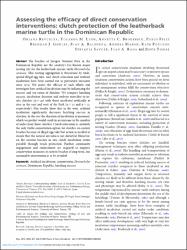Mostrar el registro sencillo del ítem
Assessing the efficacy of direct conservation interventions : clutch protection of the leatherback marine turtle in the Dominican Republic
| Licencia | Creative Commons Attribution licence, which permits unrestricted re-use, distribution, and reproduction in any medium, provided the original work is properly cited. | es |
| Autor | Revuelta, Ohiana | |
| Autor | León, Yolanda M. | |
| Autor | Broderick, Annette C. | |
| Autor | Féliz, Pablo | |
| Autor | Godley, Brendan J. | |
| Autor | Balbuena, Juan A. | |
| Autor | Mason, Andrea | |
| Autor | Poulton, Kate | |
| Autor | Savoré, Stefania | |
| Autor | Raga, Juan A. | |
| Autor | Tomás, Jesús | |
| Fecha de admisión | 2022-05-31T01:37:06Z | |
| Fecha disponible | 2022-05-31T01:37:06Z | |
| Año | 2015 | |
| Citación | Revuelta, O., León, Y. M., Broderick, A. C., Féliz, P., Godley, B. J., Balbuena, J. A., ... & Tomás, J. (2015). Assessing the efficacy of direct conservation interventions: clutch protection of the leatherback marine turtle in the Dominican Republic. Oryx, 49(4), 677-686. Recuperado de: | es |
| URI | https://bvearmb.do/handle/123456789/1008 | |
| Sinopsis | The beaches of Jaragua National Park in the Dominican Republic are the country's last known major nesting site for the leatherback marine turtle Dermochelys coriacea. This nesting aggregation is threatened by widespread illegal egg take, and clutch relocation and artificial incubation have been carried out as protection measures since 1974. We assess the efficacy of such efforts and investigate how artificial incubation may be influencing the success and sex ratios of clutches. We compare hatching success, incubation duration and embryo mortality in in-situ clutches (n = 43) with those incubated artificially at sites in the east and west of the Park (n = 35 and n = 31, respectively). Our results show that in the west, artificial incubation significantly decreases hatching success in clutches. In the east the duration of incubation is increased, which we predict would result in an increase in the number of males from these clutches. Clutch relocation is currently the only viable conservation option for clutches on eastern beaches because of illegal egg take but action is needed to ensure that the natural sex ratio is not distorted. However, on the western beaches in situ clutch incubation seems possible through beach protection. Further community engagement and enforcement are required to improve conservation measures at eastern beaches if long-term, less sustainable intervention is to be avoided. | es |
| Idioma | English | es |
| Publicado | Oryx [ISSN: 1365-3008], 49(4), 677-686. | es |
| Derechos | © 2014 Fauna & Flora International. Published online by Cambridge University Press. | es |
| URI de derechos | http://creativecommons.org/licenses/by/4.0/ | es |
| Materia | Biodiversidad - República Dominicana | es |
| Materia | Hábitats y especies | es |
| Materia | Fauna ─ República Dominicana | es |
| Materia | Especies amenazadas | es |
| Título | Assessing the efficacy of direct conservation interventions : clutch protection of the leatherback marine turtle in the Dominican Republic | es |
| Tipo de material | Article | es |
| Tipo de contenido | Scientific research | es |
| Acceso | Open | es |
| Audiencia | Technicians, professionals and scientists | es |
Ficheros en el ítem
Este ítem aparece en la(s) siguiente(s) colección(es)
-
Investigación ambiental [1759]
La consulta y descarga de este documento están sujetas a esta licencia: Creative Commons Attribution licence, which permits unrestricted re-use, distribution, and reproduction in any medium, provided the original work is properly cited.
© 2014 Fauna & Flora International. Published online by Cambridge University Press.
© 2014 Fauna & Flora International. Published online by Cambridge University Press.


